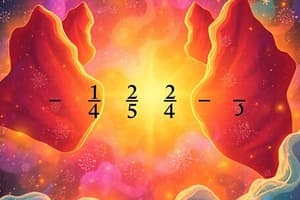Podcast
Questions and Answers
What is the result of subtracting 5/6 - 2/3?
What is the result of subtracting 5/6 - 2/3?
- 1/4
- 1/2
- 2/3
- 1/3 (correct)
In the fraction 4/7 + 1/2, which of the following is the correct simplified form?
In the fraction 4/7 + 1/2, which of the following is the correct simplified form?
- 7/14 (correct)
- 12/14
- 5/9
- 8/14
If 3/5 of a group of students are girls, what fraction of the group are boys?
If 3/5 of a group of students are girls, what fraction of the group are boys?
- 1/5
- 2/3
- 1/3 (correct)
- 4/7
A recipe calls for 2 cups of milk. If you want to make half the recipe, how many cups of milk should you use?
A recipe calls for 2 cups of milk. If you want to make half the recipe, how many cups of milk should you use?
If you have $80, and you spend 3/4 of it, how much money remains?
If you have $80, and you spend 3/4 of it, how much money remains?
Study Notes
Maths for Class 6 - Introduction to Fractions
Fractions are one of the fundamental concepts introduced in mathematics classes from early primary school levels. This chapter will focus on the concept of fractions and their applications for students in grade six.
Understanding Fractions
A fraction is a way to represent parts of a whole quantity. For example, if you have two apples out of five, we can say it is expressed as 2/5 of the total number of apples. Here's how we can make sense of this concept:
Numerator & Denominator
In the expression 2/5, the number 2 before the slash is called the numerator, while the number 5 after the slash is referred to as the denominator.
The numerator represents the part you want, while the denominator tells us what the whole is divided into equal parts. In our case, there are five equal parts, so each part represents 1/5 of the whole.
Comparing Fractions with Whole Numbers
Comparing a fraction to a whole number involves comparing the value of the fraction to the equivalent whole number. For instance, 1/2 is half of the whole number 2. Similarly, 3/4 is three-quarters of the whole number 4. By understanding this relationship between fractions and whole numbers, we can better grasp the value of different quantities represented by fractions.
Addition & Subtraction of Fractions
Adding or subtracting fractions requires finding a common denominator. For example, to find the sum of 2/3 + 3/4, we need to find a common multiple of both 3 and 4 that isn't already a factor of either. One such common denominator would be 12, and the result of adding these fractions would be 7/12.
Similarly, subtracting fractions follows a similar pattern. For instance, 3/4 - 1/2 = 1/4 because they share a common denominator of 4.
Solving Real-Life Problems Using Fractions
Real-life situations can be solved using fractions. For instance, say you have a pizza that costs $9, and you pay ⅔ of the cost. To know how much money you've paid, you simply multiply ⅔ by $9, which gives you $6.
This illustrates how fractions help us understand percentages and ratios. For example, a recipe might call for ½ cup of flour, meaning that the entire amount of flour needed is twice that amount. Conversely, a recipe might call for ¼ cup of sugar, meaning you'll need four times the amount called for.
Fractions Word Problem Examples
As a grade six student, you'll likely encounter fractions word problems in various forms. Here are some examples that illustrate problem-solving scenarios involving fractions:
Example 1
If one-third of 12 students prefer chocolate ice cream, how many like vanilla?
To solve this problem, we need to determine what fraction represents that number. One-third of 12 students would be 12/3 or 4, so there would be 4 students who prefer vanilla ice cream.
Example 2
In a class of 24 girls, two-fifths prefer sports over arts. How many like sports?
In this scenario, we have a total of 24 girls, and each girl represents 1 part. So, if two-fifths of them prefer sports (which means they represent 2/5 parts), we multiply 2/5 * 24 to get 16 girls who prefer sports.
Fractions Summary
Fractions form a crucial part of mathematics education, allowing students to understand and solve problems involving parts of a whole. By learning about fractions, grade six students develop essential skills in problem-solving and real-life applications. As they progress through their math curriculum, fractions will continue to play a significant role in their understanding of mathematics and its practical applications.
Studying That Suits You
Use AI to generate personalized quizzes and flashcards to suit your learning preferences.
Description
This quiz covers the fundamental concept of fractions, including understanding fractions, comparing them with whole numbers, addition, subtraction, solving real-life problems using fractions, and examples of fraction word problems that grade six students might encounter.




